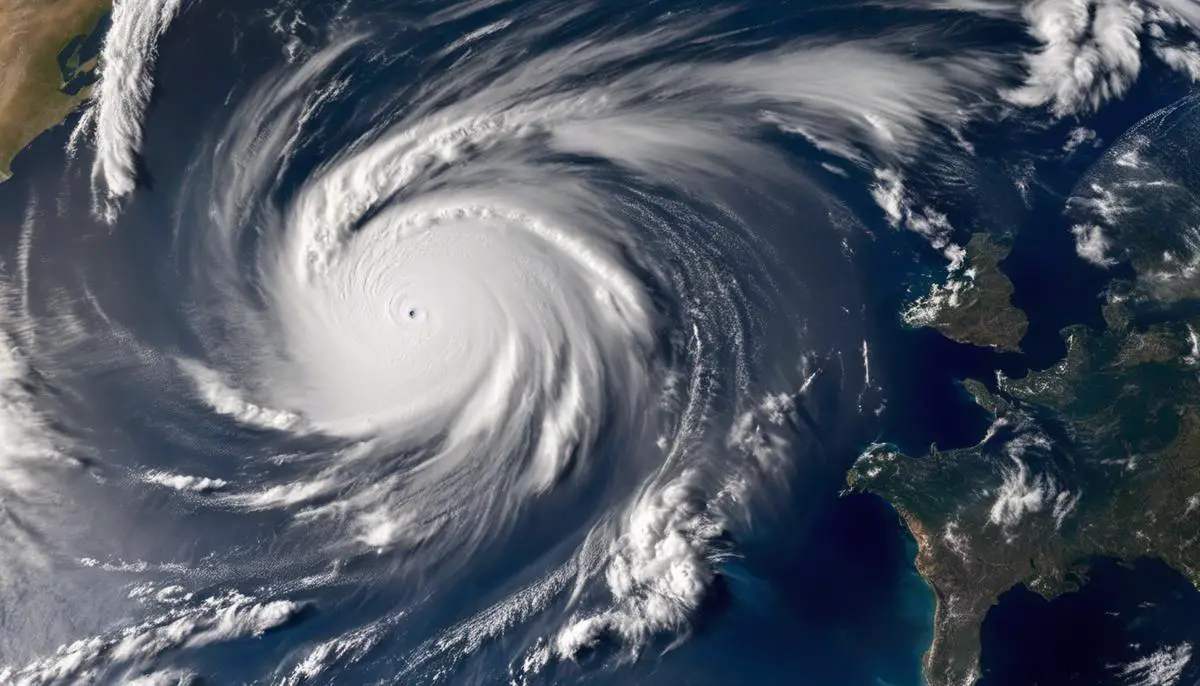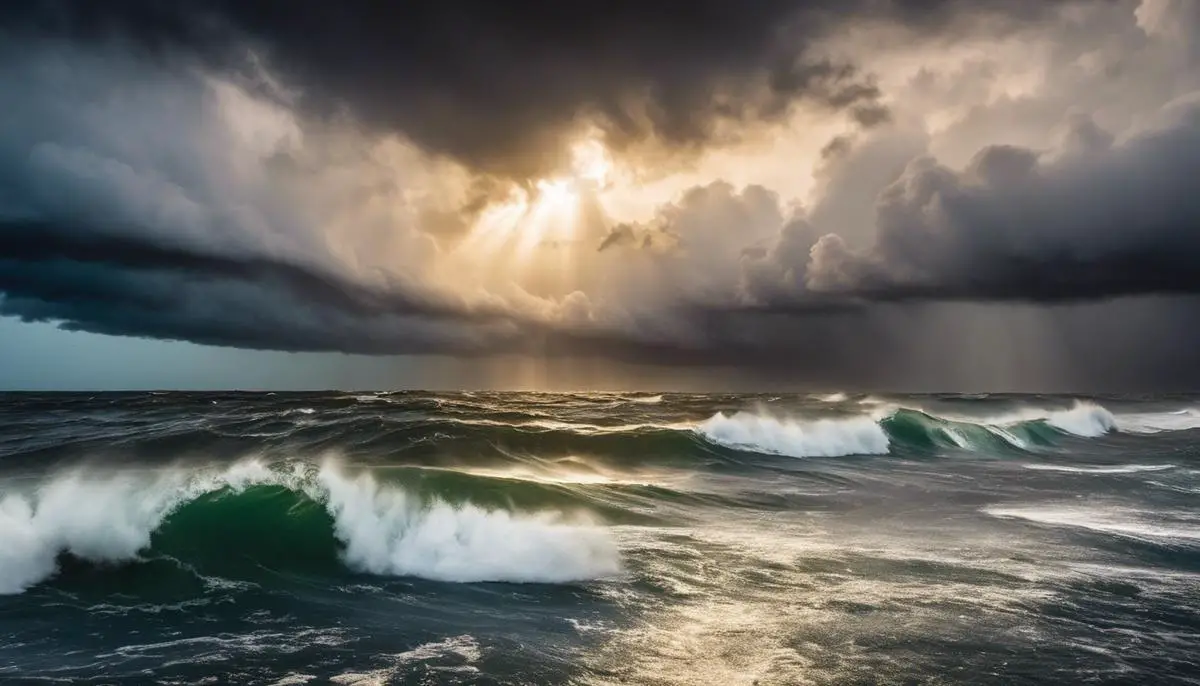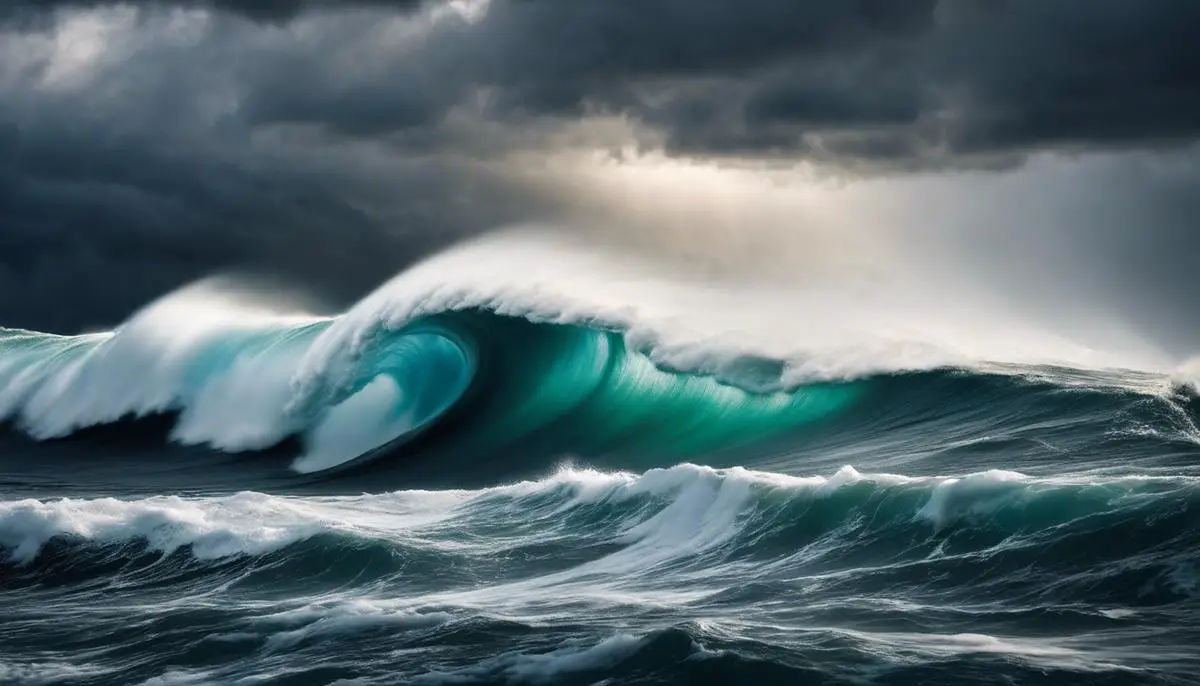Living in Florida, the significance of understanding hurricanes and their patterns becomes evident. These powerful storms are a natural, yet imposing part of Floridian life and knowing how hurricanes form and escalate can help us better anticipate these episodes. In this examination, we delve into the factors contributing to hurricanes’ development and severity, with a specific focus on atmospheric conditions like sea surface temperatures, wind speed, and atmospheric pressure. Following this, we unearth the climatological features of Florida’s hurricane season and examine the trends that have played out over the years. And, to highlight the sweeping effects of these hurricane events, we scrutinize a historic timeline showcasing major hurricanes that have left Florida grappling with destruction and economic uncertainties.
Understanding Hurricanes: Formation and Intensity
Understanding the formation and intensity of hurricanes begins with a voyage into the profound depths of our planet’s atmospheric systems. Hurricanes, also known as tropical cyclones in meteorological terms, are enormous, spiraling storm systems characterized by low-pressure centers and numerous thunderstorms that produce severe winds and torrential rainfall. This complex and awe-inspiring scientific phenomenon is borne out of a multitude of factors and processes that hinge primarily upon climatic and atmospheric conditions.
To understand beginnings, we need to focus on the ocean – it is indeed the cradle of hurricanes. Our journey begins in a serene body of water where the sea surface temperature exceeds 26.5 degrees Celsius. This warmth in the tropical ocean waters is the crucible for hurricane formation, providing the necessary energy to fuel these systems.
As the warm, moist air above the ocean surface rises dynamically, it leaves behind an area of lower pressure. This area is filled rapidly by the surrounding air rushing in, subsequently spiraling upwards due to the Earth’s rotation, leading to the birth of a cyclone.
Moving upwards, the moisture-laden air cools down, resulting in the formation of clouds and releasing latent heat. This virtuous cycle continues, sustaining and intensifying the cyclone. Keep in mind that for cyclonic circulation to mature into a devastating hurricane, the atmospheric conditions must be just right, including minimal vertical shear—changes in wind speed with height.
It’s important to note that not every hurricane is created equal. The intensity of these atmospheric behemoths is modulated by numerous factors. Interestingly, the heat content of the ocean and the structure of the hurricane itself significantly contribute to its intensity. Essentially, hurricanes draw energy from the warm ocean surface to amplify, and a phenomenon called ‘eyewall replacement cycles’ can lead to changes in the strength.
Predicting the intensity of hurricanes can be a formidable task, with changes often occurring rapidly and without much prior warning. One amplifying factor that continues to perplex scientists is the process of rapid intensification, where storms intensify explosively in a short period. While our understanding is advancing, it remains an area of intensive research and focus.
Despite our vast knowledge of hurricanes, they continue to be both a source of fascination and dread. Each storm presents a unique narrative of nature’s power, reminding us of both our vulnerability and the resilience of our planet. This constant intertwining of awe and understanding pushes us further into the pursuit of knowledge, showcasing the ceaseless beauty of science.

The Climatology of Florida’s Hurricane Season
As we delve deeper into the progression of hurricane season in Florida, an insightful pattern emerges. This seasonal cycle of tropical cyclone activity is not random but shows a discernible chronological progression and intensity, greatly dependent on the complex interaction of climatic factors.
From June through November, Floridians keep a vigilant eye on the Atlantic Ocean’s oppressive heat. This is the hurricane season, and the peak is statistically seen in August through October, with September often witnessing the maximum activity. However, the appearance of these deadly weather phenomena isn’t evenly distributed throughout the season, and delving into the reasons underscores the profound intricacies of atmospheric science.
Subtropical and Tropical storms, the lesser cousins of full-fledged hurricanes, often mark the beginning and end of the Florida hurricane season. During these periods, the waters off Florida’s coast have not yet reached—or have cooled from—the high temperatures required to fuel more intense hurricanes. These storms more frequently develop not off the coast of Africa, the birthplace of many hurricanes, but rather from the remnants of cold fronts in the Gulf of Mexico, the Atlantic off the southeastern U.S. coast, and the Caribbean Sea.
As the summer sun bakes the Atlantic waters in the months of August and September, conditions become ripe for brewing major hurricanes. The warm waters create a favorable environment for thunderstorm activity, and the winds aloft are conducive to cyclone formation. Storms beginning off the coastline of Africa, referred to as Cape Verde storms, have a long stretch of warm water to gather strength before potentially making landfall. It is in these months that Florida faces the greatest probability of experiencing the most devastating of hurricane impacts.
Freezing weather patterns in higher latitudes have an impact as well. In the late fall, as the jet stream dips southward, it brings along stronger wind shear that can cut developing cyclones off at the knees, ushering in the decline of the hurricane season. It’s a progressive cycle, a dance of natural forces that ebbs and flows with the changing seasons.
Being cognizant of these seasonal hurricane trends is crucial, as preparation can significantly mitigate the devastating impacts of hurricanes. Just as the field of hurricane research advances, so must societal resilience against their power.
An understanding of hurricanes goes beyond science. It’s a testament to the delicious complexity and power of our planet. It’s appreciating that our weather is not chaotic or random, but rather governed by processes and conditions that are interconnected in ways that are truly astounding. As the incredible power and intricacy of hurricanes are pondered, one cannot help but feel a sense of awe—even respect—for these mighty manifestations of Mother Nature’s power. Stand in reverence of their destructive potential, while also harnessing the dedication and resilience inherent in ourselves to learn, adapt, and overcome.

Historical Hurricane Events in Florida
Delving deeper into the annals of Florida’s maritime history, it is fascinating to contextualize significant hurricane events that have left indelible marks, not only on Floridian landscapes but also on the collective consciousness of its populace. Natural phenomena, resonating with both creative and destructive undertones, are reminders of the interconnectedness of everything on the planet and the necessity to adapt to our environment’s cyclical rhythms and patterns.
From the onset of the 20th century, Florida has commemoratively yet ruefully named numerous hurricanes. The hurricane of 1928, also called The Okeechobee Hurricane, stands prominently in our collective memory, a stark reminder of the unpredictability and destructive power of hurricanes. This category 4 hurricane, after traversing the Atlantic, cut a devastating path through southern Florida causing extensive fatalities, scooping up everything in its path with winds reaching a terrifying 155 miles per hour. The Lake Okeechobee levee failure led to catastrophic flooding, highlighting the importance of infrastructure preparedness in hurricane vulnerability.
Next, the 1935 Labor Day Hurricane is considered one of the most intense hurricanes to make United States landfall. This compact yet powerful storm, a category 5 hurricane, caused catastrophic damage in the Florida Keys, as it packed wind speeds up to 185 miles per hour. It’s a somber testament to the sheer power of hurricanes, in particular to the potential consequences of rapid intensification – a phenomenon our scientific community is diligently working to better understand and predict.
Fast forward to 1992, when Hurricane Andrew, another category 5 hurricane, ripped through southern Florida, notably Miami-Dade County, characterized by its swift speed, compact size, and unexpected intensification. The demolition was widespread, with trees uprooted, houses razed, and widespread infrastructural damage. Andrew served as a crucial wake-up call to the importance of adhering to stricter building codes for hurricane-prone areas and was pivotal in the development of a more structured, proactive, and robust hurricane response system.
In recent memory, we have the impactful event of 2005’s Hurricane Katrina and Hurricane Wilma. Katrina, though only a category 1 upon hitting Florida, later evolved into the hurricane that devastated New Orleans. Following closely on Katrina’s heels was Wilma, a category 3 hurricane, which caused expansive damage across South Florida as it cut a path across the peninsula.
These events underscore the necessity for continual research and exploration into hurricanes, our ability to predict, prepare, and recover from them, and the overall resilience and adaptability of our socio-ecological systems. It’s a testament to the ceaseless dedication of our scientific community that continue to learn from these devastating events, rigorously monitoring weather patterns and climate interactions, forecasting hurricane events with good accuracy, advancing protective infrastructural strategies, and instilling preparedness measures among communities.
In conclusion, it is through understanding and respecting the ferocious potential of hurricanes that we can leverage our knowledge, harnessing resilience through education and adaptation practices, all while marveling at the vicissitudes woven into the fabric of our planet’s meteorological portrait. Hurricanes, intricate parts of the planet’s weather system, are indeed a testament to the profound yet humbling complexity of the world.

Predictive Modelling and Hurricane Forecasting
Given an established understanding of the nature and dynamics of hurricanes, it becomes imperative to delve into the domain of hurricane forecasting. This field, a significant aspect of meteorology, relies extensively on computational models and distinct methodologies to predict the path and intensity of these massive storm systems.
One of the most frequently employed models in hurricane forecasting is the dynamical model, which depends on mathematical calculations of the physical processes that influence hurricanes. The interaction of air, water, and heat is examined under the laws of physics to simulate or predict a hurricane’s future path and intensity. This model is divided into global models, which capture a broad overview of atmospheric conditions, and regional models, which provide a more intricate focus on the specific area of hurricane activity.
Within dynamic models, NCEP’s Global Forecasting System (GFS) and NOAA’s Hurricane Weather Research and Forecasting Model (HWRF) are often utilized. The GFS provides initial conditions and future predictions for the entire atmosphere globally and is essential for forecasting the routes of hurricanes. On the other hand, the HWRF, as a regional model, offers valuable insights into the intensity changes of a hurricane.
Another category of prediction models are statistical models. Rooted in historical storm data and patterns, these models draw predictions by comparing present storm conditions with those of past storms that exhibited similar characteristics. The Statistical Hurricane Intensity Prediction Scheme (SHIPS) and the Climatology and Persistence Model (CLIPER) fall under this category.
Ensemble methods, another vital part of modern forecasting, combine predictions from multiple models to create a consensus forecast. The advancements of AI and machine learning algorithms amplify the effectiveness of these ensemble methods, which can result in more precise forecasts.
Despite the sophistication of these models, predicting hurricane intensity changes, especially rapid intensification events, remain a considerable challenge. While the track accuracy of hurricane forecasts has markedly improved over time, intensity forecasting has not demonstrated equivalent progress, indicating a critical area for ongoing research.
Satellite technology and remote sensing further contribute to the accuracy of hurricane prediction. Data from orbital platforms like the GOES (Geostationary Operational Environmental Satellites) provide meteorologists with real-time imaging of the hurricane’s evolution and environmental factors that may influence its direction and intensity.
In conclusion, hurricane forecasting is an intricate weaving of theory, data analysis, computational models, and technology to provide timely alerts to potentially affected regions, enhancing our preparedness and resilience against these formidable natural phenomena. The dichotomy of awe-inspiring and devastating, hurricanes serve as a beacon, reminding us of our place within, and responsibility towards, this complex world. Needless to say, continued efforts are needed to tackle the yet unsolved challenges of hurricane predictions, fueled by dedication, curiosity, and the unstoppable pursuit of understanding.

Mitigation and Climate Change Influence
Steering into the eye of this maelstrom, assessing the battleground against hurricanes in Florida calls for a deep comprehension of the intricate interplay of climatic, geographical, and human factors involved. In this struggle, mitigation strategies stand as crucial bulwarks that can dampen the destructive impacts of these extreme weather phenomena.
Appropriate urban planning has emerged as an effective tool in this regard. The architecture that we ensemble must be mindful of the howling winds and torrential rains that a hurricane encompasses. Buildings that are specifically designed to withstand these pressures can significantly reduce the damage caused. This includes using reinforced concrete, adopting more aerodynamic architectural designs, and adding hurricane shutters, which can decrease the force that a hurricane exerts on structures.
Additionally, implementing well-designed coastal zone management strategies can help reduce the vulnerability of Florida’s coastal areas. Preservation of mangroves and other coastal vegetation acts as a natural barrier against storm surges. These green embankments not only help to absorb the ferocious energy of a hurricane, but also reduce soil erosion and slow the flow of storm-driven waters into developed areas.
However, physical measures are only half of the battle. Instilling a culture of preparedness plays a quintessential role in hurricane mitigation. This includes developing comprehensive evacuation plans, raising public awareness about hurricanes and their potential hazards, encouraging the creation of disaster supply kits, and ensuring that citizens are timely and accurately informed about impending storms. In this context, programs like the National Hurricane Program, which provides technical assistance and advice to coastal areas prone to hurricanes, have made a noteworthy impact.
Climate change, the lurking tempest, adds an ominous layer to this discourse. Warmer oceanic waters provide more energy for storm systems, potentially leading to more potent hurricanes. The Intergovernmental Panel on Climate Change (IPCC) suggests an increased probability of intense, once-a-century storm surges. Additionally, rising sea levels compound this risk by amplifying the destructive potential of storm surges.
From a scientific perspective, dissecting the relationship between hurricanes and climate change remains a nuanced task. While one cannot point to climate change as the sole driver for any individual storm, many agree that it likely intensifies the impact. Similarly, the links between climate change and hurricane frequency remain unclear, with ongoing debate in the scientific community, reflecting yet again the complexity that engulfs the study of hurricanes.
Regardless, as responsible scientists and citizens, the imperative falls upon addressing the climate crisis in tandem with advancing our understanding and preparedness of hurricanes. If we are to weather the storms of the future, it becomes incumbent on us to reduce our greenhouse gas emissions, cut our carbon footprint, and rally together towards a more sustainable future. In this unfolding narrative, the role of every individual, community, and institution becomes pivotal.
Standing at this juncture, the story of hurricanes in Florida is one of resilience, adaptation, and continuous learning. Keep grappling with the scientific enigmas these natural phenomena propose, investing in preparedness, and combating the broader environmental challenges, we ensure our survival and growth in the embrace of our astonishing blue planet.

Reading these topics hopefully underpins the truth that adequate readiness and informed strategies can help minimize the impact of these catastrophic hurricanes. The science behind predictive modelling and forecasting can give us the foresight necessitated to prepare and mitigate their effects. This signifies the value of accurate prediction models and techniques, albeit with their limitations. Further, it is crucial to regard the global issue of climate change and its potential influence on these tropical tempests. As we continue to navigate a future wrought with climatic uncertainties, understanding the evolving dynamics of hurricanes becomes a necessity for Florida – a state with a history inseparable from these imposing weather phenomena.
![]()
